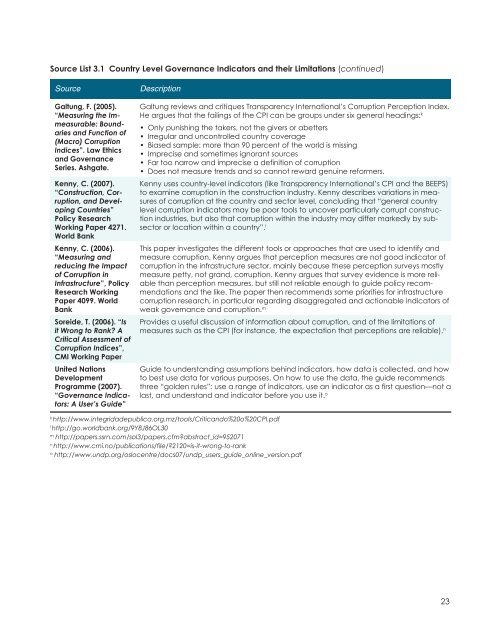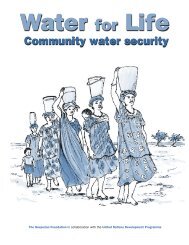A Sourcebook - UN-Water
A Sourcebook - UN-Water
A Sourcebook - UN-Water
Create successful ePaper yourself
Turn your PDF publications into a flip-book with our unique Google optimized e-Paper software.
Source List 3.1 Country Level Governance Indicators and their Limitations (continued)<br />
Source<br />
Galtung, F. (2005).<br />
“Measuring the Immeasurable:<br />
Boundaries<br />
and Function of<br />
(Macro) Corruption<br />
Indices”. Law Ethics<br />
and Governance<br />
Series. Ashgate.<br />
Kenny, C. (2007).<br />
“Construction, Corruption,<br />
and Developing<br />
Countries”<br />
Policy Research<br />
Working Paper 4271.<br />
World Bank<br />
Kenny, C. (2006).<br />
“Measuring and<br />
reducing the Impact<br />
of Corruption in<br />
Infrastructure”, Policy<br />
Research Working<br />
Paper 4099. World<br />
Bank<br />
Soreide, T. (2006). “Is<br />
it Wrong to Rank? A<br />
Critical Assessment of<br />
Corruption Indices”,<br />
CMI Working Paper<br />
United Nations<br />
Development<br />
Programme (2007).<br />
“Governance Indicators:<br />
A User’s Guide”<br />
Description<br />
Galtung reviews and critiques Transparency International’s Corruption Perception Index.<br />
He argues that the failings of the CPI can be groups under six general headings: k<br />
• Only punishing the takers, not the givers or abetters<br />
• Irregular and uncontrolled country coverage<br />
• Biased sample: more than 90 percent of the world is missing<br />
• Imprecise and sometimes ignorant sources<br />
• Far too narrow and imprecise a definition of corruption<br />
• Does not measure trends and so cannot reward genuine reformers.<br />
Kenny uses country-level indicators (like Transparency International’s CPI and the BEEPS)<br />
to examine corruption in the construction industry. Kenny describes variations in measures<br />
of corruption at the country and sector level, concluding that “general country<br />
level corruption indicators may be poor tools to uncover particularly corrupt construction<br />
industries, but also that corruption within the industry may differ markedly by subsector<br />
or location within a country”. l<br />
This paper investigates the different tools or approaches that are used to identify and<br />
measure corruption. Kenny argues that perception measures are not good indicator of<br />
corruption in the infrastructure sector, mainly because these perception surveys mostly<br />
measure petty, not grand, corruption. Kenny argues that survey evidence is more reliable<br />
than perception measures, but still not reliable enough to guide policy recommendations<br />
and the like. The paper then recommends some priorities for infrastructure<br />
corruption research, in particular regarding disaggregated and actionable indicators of<br />
weak governance and corruption. m<br />
Provides a useful discussion of information about corruption, and of the limitations of<br />
measures such as the CPI (for instance, the expectation that perceptions are reliable). n<br />
Guide to understanding assumptions behind indicators, how data is collected, and how<br />
to best use data for various purposes. On how to use the data, the guide recommends<br />
three “golden rules”: use a range of indicators, use an indicator as a first question—not a<br />
last, and understand and indicator before you use it. o<br />
k<br />
http://www.integridadepublica.org.mz/tools/Criticando%20o%20CPI.pdf<br />
l<br />
http://go.worldbank.org/9Y8J86OL30<br />
m<br />
http://papers.ssrn.com/sol3/papers.cfm?abstract_id=952071<br />
n<br />
http://www.cmi.no/publications/file/?2120=is-it-wrong-to-rank<br />
o<br />
http://www.undp.org/oslocentre/docs07/undp_users_guide_online_version.pdf<br />
23
















